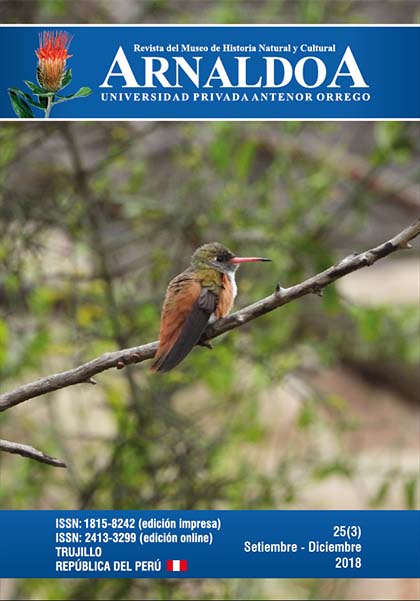ESTRUCTURA Y COMPOSICIÓN FLORÍSTICA DEL BOSQUE SIEMPREVERDE MONTANO BAJO DE LA PARROQUIA SAN ANDRÉS, CANTÓN CHINCHIPE, PROVINCIA DE ZAMORA CHINCHIPE, ECUADOR
DOI:
https://doi.org/10.22497/944Abstract
Resumen
Para planificar la conservación de los bosques es necesario conocer su estructura y composición florística. Para satisfacer esta necesidad en la parroquia San Andrés, cantón Chinchipe, provincia de Zamora Chinchipe, se investigó un bosque siempreverde montano bajo, con el objetivo de determinar la diversidad florística y estructural. Se instalaron parcelas temporales de 20 m x 20 m (400 m2), se registró el DAP de todos los individuos ≥5 cm de D1,30 m, al interior se delimitaron tres subparcelas de 5 m x 5 m (25 m2) para arbustos. Se determinó: densidad absoluta (D), densidad relativa (DR), frecuencia relativa (FR), dominancia relativa (DmR) e índice valor importancia (IVI). Para los perfiles se instaló un transecto de 10 x 50 m, registrando los individuos en distancias X y Y. Se registraron 46 especies de 35 géneros y 20 familias; 33 arbóreas y 13 arbustivas. El mayor número de individuos por clases diamétricas se concentró en las clases I, II y III, que demuestra una estructura en forma de “J” invertida, típico de bosques en recuperación. Las familias más diversas en el estrato arbóreo son: Lauraceae, Melastomataceae, Rubiaceae y Euphorbiaceae; y, en el estrato arbustivo, Lauraceae, Primulaceae, Chlorantaceae y Rubiaceae. Las especies arbóreas ecológicamente importantes son: Alchornea glandulosa, Calyptranthes sp. y Nectandra lineatifolia; y en el estrato arbustivo: Psychotria brachiata, Tetrorchidiumandinum y Palicourea sp. La regeneración natural es abundante en la categoría brinzal. Cybianthus sp. y Nectandra lineatifolia son las especies que presentan mayor regeneración natural.
Palabras clave: bosque siempreverde montano bajo, composición florística, estructura diamétrica.
Â
Abstract
To plan the conservation of forests is necessary to know their structure and floristic composition. To satisfy this need in the San Andres Parish, Chinchipe Canton, province of Zamora Chinchipe, a lower montane evergreen forest was investigated, in order to determine the floristic and structural diversity. Temporary plots of 20 m x 20 m (400 m2) were installed, the DBH of all individuals ≥5 cm of D1,30 m was recorded, and three subplots of 5 m x 5 m (25 m2) were delimited for shrubs. We determined: absolute density (D), relative density (RD), relative frequency (RF), relative dominance (RDm) and importance value index (IVI). For the profiles, a transect of 10 x 50 m was installed, registering the individuals in X and Y distances. 46 species of 35 genera and 20 families were registered; 33 arboreal and 13 shrubby. The largest number of individuals per diametric classes was concentrated in classes I, II and III, which shows an inverted “J” structure, typical of recovering forests. The most diverse families in the arboreal stratum are: Lauraceae, Melastomataceae, Rubiaceae and Euphorbiaceae; and, in the shrub layer, Lauraceae, Primulaceae, Chlorantaceae and Rubiaceae. The ecologically important tree species are: Alchornea glandulosa, Calyptranthes sp. and Nectandra lineatifolia; and in the shrub layer: Psychotria brachiata, Tetrorchidium andinum and Palicourea sp. Natural regeneration is abundant in the seedling category. Cybianthus sp. and Nectandra lineatifolia are the species with the highest natural regeneration.
Keywords: lower montane evergreen forest, floristic composition, diametric structure.
Downloads
Downloads
Published
Issue
Section
License
By submitting a paper to the journal, it is understood that the authors agree to transfer the publication rights to the journal once it is accepted.
It is permitted to share and adapt the contents of this journal in any medium or format always if the original source is properly cited and there are not commercial purposes.







